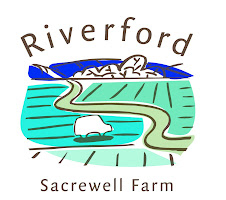MONDAY 29TH JUNE 2009
I'm worried about my crop already. We're in London all day today and for the best part of tomorrow too and I'm concerned about the plants dying out in this scorching sun! It is seriously hot and the plot has no shade whatsoever, so I'm hoping the horticultural fleece will offer some protection. My friend Peter is unavailable too, so the plants that went in the ground on Sunday are going to have to hold their own for a couple of days. Poor planning on my part, by not arranging for a friend or neighboring allotment holder to give them a sprinkling for me. I do hope they'll be OK.
TUESDAY 30TH JUNE 2009
It's even hotter today and I spend most of the day in the car enjoying London's traffic jams and worrying about my young crop. I arrived for my business meeting an hour early, so took the opportunity to pop into the nearby B&Q store to pick up an extension for my watering hose. I already have a hose at the allotment, which was a spare I had taken from home, so it didn't cost me anything. However, it's not long enough to extend the whole length of the plot, so I needed an extension. I've also purchased a spray gun attachment for the end, which controls the power and pattern of the spray. Another £20 spent.
We arrived home just after 6.30pm and my first job was to get changed and head straight to the allotment to see if the crop had managed to survive without water for two days. However, my friend Nick had popped in to pick up a bike that I'd promised to sell him. After taking it for a quick spin, he decided to buy it and we then relaxed on the patio for a while and enjoyed a nice cold drink. I'm anxious to get to the allotment, but another few minutes in the evening sun can't do the plants any more harm, surely? I notice the books I ordered have arrived, but they'll have to wait until later. The second Nick heads off on his newly acquired bicycle, I'm off to get some water on the plants!
It's nearly 7.30pm before I get onto the plot. I peel back the cover and the plants are fine, phew! The horticultural fleece has done its job. A couple of the younger Broad Bean and Cabbage plants are looking a touch wilted, but nothing a good soaking won't sort out. Most of the plants look very healthy and strong. The shoots from the Pepper seedlings look particularly strong and a vibrant green, which is surprising, as they were the most delicate of all the seedlings we planted on Sunday. I connect up the new hose extension and gun-attachment and create an artificial rain shower over the crop for the next fifteen minutes. Then I cover the plants with the fleece once more and all is well once again in allotment land.
WEDNESDAY 1ST JULY 2009
Being less anxious about the plants today, I got home about 5.30pm and decided to get acquainted with the new books that have arrived from Amazon, before going to water the plants. Both books look very good indeed, although at first glance, the Alan Buckingham book 'Allotment Month By Month' looks the more practical of the two, whereas the Andi Clevely book 'The Allotment Book' seems to have quite a 'lifestyle' angle to it; in the sense that there are more pictures showing an allotment as a place of relaxation with shading trees and grassed areas and one picture showing a caravan being used in place of a shed, with plants growing in it, on it and under it; and people sitting outside on deckchairs drinking tea!
However, both books concentrate on three main things to start with. 1. Having the right tools and equipment (which I do), 2. Clearing the site (which is done), and 3. Planning how you want to set out your plot (which I haven't done yet). For the moment, all I've done is copy the neighbors by planting across the plot in simple rows. According to the books, there are several ways of doing it which avoid compacting the soil by treading up and down the rows and also allow you to manage crop-rotation much easier over the seasons. The raised-bed system looks of particular interest. I'll cover this in more detail in a future blog, if indeed, it's the system decided on.
On my way to the allotment this evening, I popped in to see Peter. He is as keen as I am to get some more plants in and has already planted some of the seeds we brought last week into pots. There's still time to get some crops going this year, including carrots, cabbage, broccoli and spuds, which we can harvest up to and during the winter. We chatted about our plans and decided we need to find out more about the soil type, which will be a task over the coming weeks and something I can consult the books about. We also chatted about composting and how we can conveniently collect our food waste and get it to the allotment. Peter made a very valid point in that "you only get out of the soil what you put into it", so we need to do everything we can to maintain its fertility.
Getting to the allotment tonight, my only task was to water the plants and, what with the hose being set up and laid out properly now, it was just a case of switching on the water, uncovering the plants and pointing the spray onto them before covering up again. I've got plans for tomorrow night, so won't be able to water until Friday, but am now confident that the crop will manage OK until then - especially as I gave the cover a good watering too, which will maintain a little more moisture.
FRIDAY 3RD JULY 2009
Possibly the very last thing I expected when taking on this allotment, was to get an email from Peter listing the various seeds we have in a spreadsheet, along with a calendar for planting them. Welcome to allotmenteering, 21st Century style! Peter is going to join me at the allotment on Sunday.It rained at lunchtime, so there was no particular need to go to the allotment today.
SATURDAY 4TH JULY 2009
Nothing to report today, other than going over to the plot in the evening to give the plants a good watering. It's amazing how much they've grown in only a week, which is very encouraging.
SUNDAY 5TH JULY 2009
Peter came with me today and took his first look at the allotment. I think he was quite taken aback at the physical size of it and had visions of it being only half the size. The plot is 100sq.M and will be enough to keep us fed for a good part of the year once we get into full production next year. We examined the neighboring plots and it was clear that some were over-producing and that some crops would go to waste - something we're keen to avoid doing. Other people, however, had the proportions right and were obviously staging the planting of each vegetable so they could get a staged harvest throughout the season. These are the people to learn from.
I mentioned to Peter the idea of creating raised-beds as mentioned in the books, which he liked a lot. Rather than planting in regimented rows (like everyone else seems to be doing), we will create growing areas by arranging planks of wood, each measuring 6" high x 2M long. Most beds will be 2M wide x 4M in length, which will work perfectly for the dimensions of fleece and netting that might be used to cover them. The beds don't all have to be arranged in the same direction either, so we can create a more interesting vegetable garden to look at. We can also create triangular beds 2M long on all three sides. However we decide to arrange these beds, the plan is to leave a 1' gap between them for walking on. This will ensure that the soil only gets compacted in the walk ways.
There should be many benefits to having the raised-bed system. One of the major benefits is that it will help keep slugs away from the plants, as there will be a physical barrier to stop them from getting to them. Another is that the planning of crop rotation will be much easier to ensure that soil fertility is maintained.
When we got back to Peter's house, he showed me the seeds he had planted a couple of weeks ago. I was amazed to see that the cabbage and cauliflower seeds had already germinated and were growing fast. The beans he had planted were yet to shoot. I will take the cabbage and cauliflower seedlings and get them into the ground this coming week.
Monday, 6 July 2009
Subscribe to:
Post Comments (Atom)















No comments:
Post a Comment